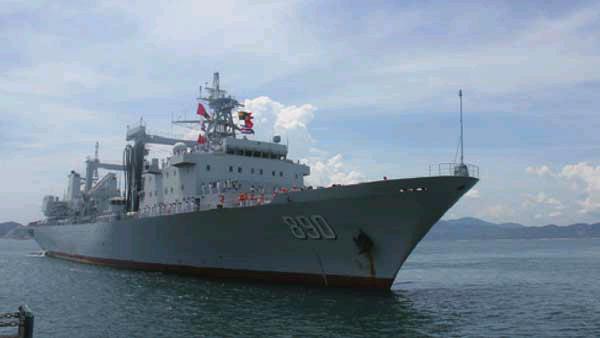A Turning Point?
2016-12-21ByMaXiaolin
By+Ma+Xiaolin
Viet Nam and the Philippines have taken pragmatic steps to mend ties with China after new administrations took office in both countries this summer. The newly elected Vietnamese Prime Minister, Nguyen Xuan Phuc, paid his first state visit to Beijing on September 13. Around a month later, from October 18-21, the newly-elected Philippine President, Rodrigo Duterte, made an ice-breaking trip to China. The two official visits, made feasible by diplomatic efforts on both sides, have helped improve both sets of bilateral relations following the strain caused over the last two years over the South China Sea issue.
Cooling tension
The first major breakthrough in China-Viet Nam relations took place on the security front. On October 22, the Chinese Navys 23rd escort fleet berthed in Cam Ranh Bay in central Viet Nam, underlining this improvement. The Chinese fleet, consisting of two missile frigates and one supply ship, paid a five-day friendly visit to the strategic port. During the stay, the Chinese Navy—on its first visit to Cam Ranh Bay—conducted a multi-dimensional exchange with the Vietnamese Navy.
Normally, Viet Nam would not allow the military vessels of another nation to berth at Cam Ranh Bay if bilateral relations were poor. In the past, China and Viet Nam engaged in several armed conflicts and were embroiled in disputes regarding the South China Sea.
This summer, tension caused by the South China Sea arbitration by a Hague-based tribunal that was unilaterally initiated by the Philippines caught the attention of the international community. Hanoi has been closely watching the development of the arbitration case from the very beginning, but decided to resort to communication and dialogue instead of risking confrontation with China. The bay visit reflects Viet Nams wish to mend ties with China and maintain normal military exchanges and mutual trust in politics and security.
The country walks a fine line between the U.S.-Japan regional alliance and its close neighbor—China. The recent political and military visits signal a remarkable change afoot in the South China Sea, meaning the strategic wall built by the United States and its allies against China is not that solid.
Dutertes adjustment
Meanwhile, Duterte has brought flexibility to the rigidity of the countrys former administrations handling of the South China Sea. On the one hand, Duterte has often been critical of Philippine-U.S. military ties, asserting that his nation has relied too much on the United States to forge an independent diplomatic policy. On the other hand, he has been working to improve the countrys relations with China and has inked a number of deals favorable to the Philippines during his Beijing trip.
Although the Philippine-U.S. relationship is unlikely to be significantly weakened, Dutertes flexible diplomacy will make Washington think twice about trying to use his country as a pawn to implement their Asia-Pacific rebalancing strategy.
The friendly signals from Viet Nam and the Philippines and the positive response from China have led to a drop in tension in the South China Sea. The two countries are expected to put aside their disputes with China for the moment, though their territorial claims in the region are likely to remain.
The Obama administration has tried to build a strategic encirclement of nations over the last five years to contain China. The fact that Viet Nam and the Philippines have taken steps to relieve tension with China indicates the U.S. attempt to isolate China is failing.
Next year, the Philippines will assume the rotating presidency of the Association of Southeast Asian Nations (ASEAN). Considering the improvement in relations between China and the two aforementioned member states, China should be able to enhance its relationship with ASEAN as well.
Whats next?
Dutertes anti-U.S. rhetoric since has raised concerns from the U.S. side, especially after he spoke of “separation” from the United States during his Beijing trip. Washington remains cau- tious about what this new Philippine president has to say and offer, while the U.S. President Barack Obama openly claimed Duterte is a“colorful person.”
Only three days after Dutertes Beijing visit, U.S. Assistant Secretary Daniel R. Russel made a hasty journey to Manila on October 24. In a meeting with the Philippine Foreign Secretary Perfecto Yasay, Russel complained that the“uncertainty about the Philippines intentions has created consternation in many countries, not only in mine.” “Thats not a positive trend,”Russel commented.
In response to warming military ties between Viet Nam and China, USS Decatur (DDG-73), an Arleigh Burke-class navy destroyer, was deployed in the waters of Chinas Xisha Islands on October 21. The intrusion of the U.S. warship resulted in Chinese protest and an immediate warning from two Chinese Navy vessels. Such a confrontation is rare on the waters of the Xisha Islands.
Some observers believe the Pentagon made such a bold move for two reasons. First, it demonstrates to the Philippines and Viet Nam that the United States is capable of dealing with China in the South China Sea without the collaboration of the two states. Second, the incident shows the United States wont change its policy on issues related to the South China Sea, regardless of objection from regional countries.
Meanwhile, Japan, the U.S. closest ally in Asia, had been assisting former Philippine President Corazon Aquino IIIs attempt to stir up tension with China. The Japanese Government has promised much investment to the Philippines and has actively sought to sell arms to the country. The country has been trying to draw more Asia-Pacific countries to its side in regional affairs to keep up pressure on China even after policy readjustment from Viet Nam and the Philippines.
According to reports by The Times of India, Japan pushed for Indian involvement in the South China Sea, despite the fact that India has nothing to do with the dispute. In fact, during Abes India visit at the end of 2015, the two sides had agreed on holding joint military exercises involving India, the United States and Japan in regional waters. By extending its confrontational policy against China to other countries, Japan could complicate the regional situation.
Nonetheless, the current lapse in tension is the result of common efforts by Chinas goodneighborly policy and the flexible strategy of adjustment from Viet Nam and the Philippines. The hard-won stability in the region should be championed by all parties involved.
